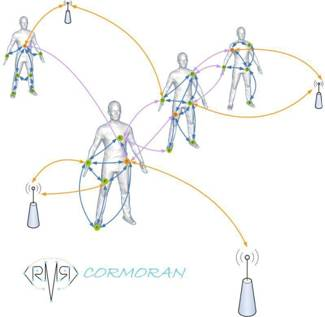I first became interested in mesh networks when I was focusing on the role of individuals in homeland security — what I call “networked homeland security.” I learned about a project at the University of Illinois that created software to form ad hoc mesh networks that could relay data between PCs, and quickly realized this could be invaluable in disasters to relay information (see my YouTube video on the subject, part of my “21st-century disaster tips you WON’T hear from officials series…).
That’s why I was particularly excited to hear about this possible component of the Internet of Things: individuals becoming nodes in mesh networks because of sensors woven into our clothing. Gigaom reports that a team of French researchers have launched the “Cormoran Project,” to create “wireless body-area networks (WBANs).”
They would capitalize on the growing number of wearable computers, from the Peeko “onesie” to Google Glass. However, the researchers visualize these devices as being more than just data sources for real-time health monitoring (as important as that is!): “Rather than just remain terminuses, they could route bits to and relay data from each other, becoming a distributed ad hoc network that constantly morphs as we move through physical space.”
Instead of requiring a dedicated link to the web, such a network would share

Cormoran Project
(BTW, collaboration will be one of my future “Essential Truth” subjects) connections and relay data from everyone who, at that moment in time, is a member of the ad hoc network because of their location.
Here’s the neat (and, equally scary!) aspect of these ad hoc human networks:
“… by linking to one another, body area networks could create new useful data about users’ surroundings and location. By measuring the signal strength of nearby connections, the network could determine the precise location of every node, or person, within it.”
The article points out that this could lead to services such as sharing information in disasters, guiding all passengers en masse to their gates, managing pedestrian traffic in cities, or studying group behavior.
Equally important, if individuals weren’t able to control access to their personal location data, it could lead to horrific invasions of personal privacy, made even more scary by the fact that hackers would be able to tell the individual’s precise location. Although I have been unable to find anything in the Cormoran literature specifically identifying privacy protections as part of the project, the EU seems to take privacy concerns about the IoT much more seriously than the U.S. government does, so let’s hope they come up with practical, enforceable protections — otherwise the downside would seem to outweigh the advantages.
